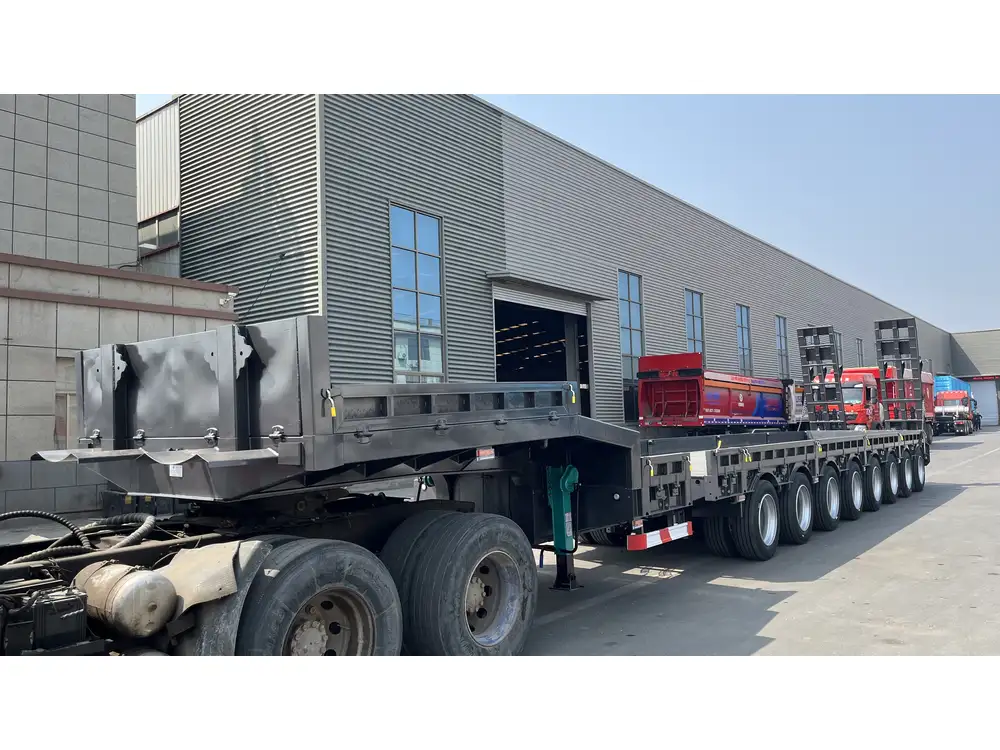Understanding Dump Trailers: The Basics
When navigating the complex world of hauling equipment and materials, the dump trailer stands out as a reliable choice. Designed to transport a variety of loads, these trailers provide versatility, convenience, and efficiency. But can you indeed load heavy equipment onto these trailers? The answer involves several factors, including the type of dump trailer, the weight of the equipment, and loading techniques.
Types of Dump Trailers
Before delving into loading specifics, it’s essential to understand the various types of dump trailers available on the market.
| Type of Dump Trailer | Description | Load Capacity | Ideal Usage |
|---|---|---|---|
| Standard Dump Trailer | Features a hydraulic lift mechanism for raising the bed | 5,000 – 15,000 lbs | General construction, landscaping |
| Heavy-Duty Dump Trailer | Built with reinforced materials for heavier loads | 15,000 – 25,000 lbs | Heavy machinery, industrial use |
| Gooseneck Dump Trailer | Attached securely to a truck bed via a gooseneck hitch | 10,000 – 20,000 lbs | Larger loads typical in agriculture |
| Enclosed Dump Trailer | Offers protection against weather and theft | 5,000 – 15,000 lbs | Landscaping, snow removal |

Key Considerations for Equipment Loading
- Weight Capacity: Every dump trailer has a specific weight capacity. Verify the details with the manufacturer before proceeding with loading.
- Distribution of Weight: Proper weight distribution is crucial. Load the equipment evenly to maintain balance and prevent swaying during transport.
- Loading Procedures: Employing the correct loading procedures ensures safety and efficiency.
Loading Equipment on a Dump Trailer
The Right Techniques
Loading equipment onto a dump trailer requires adherence to best practices to ensure safety and efficiency. Here are crucial steps to follow:
Verify Equipment Compatibility
- Check if the equipment is suitable for dump trailer loading. This includes examining dimensions and weight.
Use Adequate Equipment
- Utilize loading ramps or a forklift for safe transfer. Ramps should be compatible with both the trailer and the equipment being loaded.
Loading Process
- Drive the equipment or maneuver it onto the ramp slowly.
- Maintain a straight path while loading to avoid tipping.
- Ensure that the equipment is secured with chains or straps once loaded.
Post-Loading Inspection
- Before hitting the road, conduct a thorough inspection. Check for any signs of instability or potential issues.

Common Equipment to Load on Dump Trailers
Dump trailers can accommodate various types of equipment, enhancing their utility. Below are some commonly loaded items:
| Type of Equipment | Weight Range | Notes |
|---|---|---|
| Skid Steer Loaders | 3,000 – 8,000 lbs | Standard dump trailers can typically handle these with room for attachments. |
| Mini Excavators | 4,000 – 10,000 lbs | Verify compatibility with weight capacity. |
| Compact Tractors | 1,500 – 5,000 lbs | Easier to load due to compact size. |
| Forklifts | 4,000 – 12,000 lbs | Ensure weight distribution is optimal while loading. |
Safety Precautions
When loading equipment onto dump trailers, safety should always be a priority. Adhere to the following precautions:
- Wear Protective Gear: Always use hard hats, gloves, and steel-toed boots.
- Check for Surroundings: Clear the loading area of obstacles. Ensure that ramps or equipment are stable.
- Use Proper Signal Communication: If you have a helper, establish hand signals for loading and unloading operations.
Potential Problems When Loading Equipment
Despite meticulous planning, challenges may arise during the loading process. Understand these common issues and their solutions:
Overloading:
- Problem: Exceeding the weight capacity can lead to trailer damage or accidents.
- Solution: Weigh the load beforehand using portable scales.
Uneven Weight Distribution:
- Problem: Incorrect distribution can cause swaying or tipping.
- Solution: Load heavier equipment first and ensure even distribution across the trailer’s axles.
Failed Straps or Chains:
- Problem: Unsecured loads pose a risk to road safety.
- Solution: Regularly inspect the straps and chains for wear and check their tightness before transport.

Regulations and Legal Considerations
Before hitting the road with your dump trailer loaded with equipment, be aware of the necessary regulations:
- Weight Limits: Each state has its weight enforcement laws for vehicles. Ensure your total load complies with these laws to avoid fines.
- License Requirements: Certain heavy-duty trailers may require a special license to operate. Check local requirements.
Efficient Loading Techniques to Save Time and Cost
Efficient loading methods can significantly reduce your operational costs and increase productivity. Consider the following strategies:
Optimize Loading Ramps
- Ramp Selection: Choose ramps with high weight capacity and a non-slip surface to minimize accident risks.
- Use Adjustable Ramps: Adjustable ramps can cater to various equipment heights.

Time Management
- Pre-Loading Checks: Conduct a checklist of equipment functionality before loading to ensure that the process is smooth.
- Establish a Loading Protocol: Create a protocol that outlines exact steps for loading operations to minimize delays.
Conclusion
In conclusion, understanding the capabilities and limitations of dump trailers is critical when considering loading heavy equipment. With proper techniques, safety precautions, and adherence to regulations, hauling equipment on dump trailers can be effective and efficient.
Whether for construction, landscaping, or other industrial applications, dump trailers provide a reliable solution for transporting equipment. Always prioritize safety and best practices to ensure responsible hauling. This comprehensive guide aims to provide you with the knowledge needed to successfully load equipment onto a dump trailer while enhancing your operational efficiency and safety.
By implementing these strategies, you can maximize the utility of your dump trailer and improve your load handling processes. For further information on specific dump trailer models and additional loading solutions, feel free to reach out to us or consult with reputable manufacturers.



